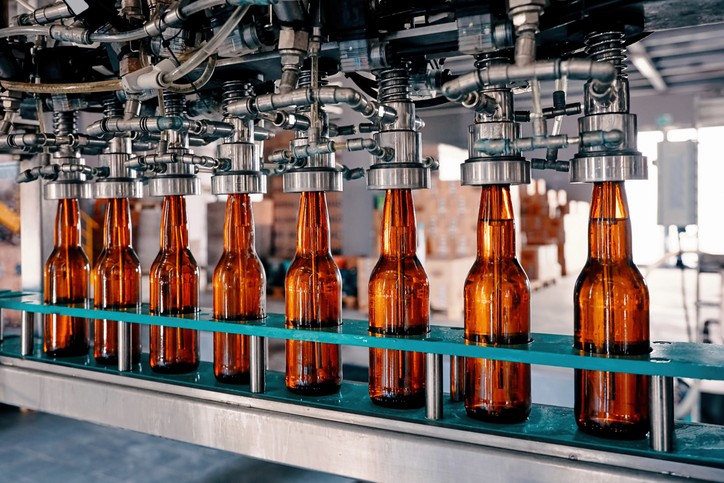Over 60% of major global beverage companies' manufacturing facilities operate in areas with medium or high water risk (BIER). As many sustainability managers know, managing water risk is an imperative for business continuity and reputation. By effectively addressing water risk, companies can gain a competitive edge and ensure the resilience of their brands and operations.
Understanding and managing local water risks is crucial for corporate sustainability managers, yet it is a complex task. In this article, we'll unpack the complexity, providing actionable insights you can use to build a water risk plan.
Why water risks are relevant for the industry
How could water risks affect your business
Processes that can help you manage water risks
Common obstacles you may face
Solutions available to address challenges
What is water risk for Sustainability Managers in the beverage industry?
Why water risks are relevant today & in the future?
Water is the most important resource for the beverage industry. It not only is a key ingredient - it also plays a key role in agricultural supply production, operations, and the cleaning and wastewater treatment processes. The industry heavily relies on water, and according to the Water Footprint Network, making just one liter of soda (equal to about 0.26 gallons) needs about 140 liters of water to produce (which is around 36 gallons), the majority of which is in the agricultural supply chain.
The dependence on water has caused various beverage companies to face operational disruptions due to water-related issues, leading to facility shutdowns in some instances. In 2022 alone, over 13% of F&B companies reported $210M in revenue losses due to water-related issues (CDP).
For these reasons, the beverage industry has increasingly prioritized water risk management, developing internal processes to measure, report, and respond to risks for long-term sustainability.
In fact, out of 17 major global beverage firms, 59% evaluate water risks and opportunities, integrating them into strategic planning and financial decisions (Ceres). Additionally, the Beverage Industry Environmental Roundtable (BIER), established in 2006, highlights collaborative efforts among top global beverage companies to promote environmental and water sustainability.
How could water risk affect your operations?
There are four types of water risk that beverage companies face, with physical risks considered to be the most relevant, especially water scarcity and quality.
Physical Risks: include water scarcity, quality, and flooding
Water scarcity occurs when the water demand exceeds the available supply, leading to a shortage. For example, Coca-Cola considers water scarcity as one of the highest economic and societal risks. For the beverage industry, a lack of water can significantly disrupt operations, directly impacting production. It can also limit the availability of other users and drive up costs due to increased competition for limited resources. To measure this risk, beverage companies often monitor current and future freshwater availability in the watersheds where they operate and track their "water use ratio” (a measure of efficiency), which measures the water required to produce one liter of the end product. For instance, Coca-Cola, PepsiCo, and AB InBev track the manufacturing water use ratio, which is defined as the liters of water withdrawn per liter of finished product.
Water quality risk refers to the potential for water sources to become contaminated or degraded, rendering the water unsuitable for its intended use. In the beverage industry, this risk manifests in two primary ways:
Firstly, incoming water supplies can become contaminated, which is particularly concerning for companies selling spring or mineral water, as they may not always be able to remove the contaminants. Even if contaminants can be removed, it can be costly to put the additional treatment and monitoring in place.
Secondly, the beverage industry has a regulatory and ethical responsibility to ensure it does not contribute to water quality problems through poorly managed wastewater or other discharges.Flooding, in addition to impacting manufacturing sites, can have an indirect impact on transportation needed for operations as well as the supply chain, including crops, thereby affecting supply availability and costs.
Regulatory Risks
Numerous regulations on water management apply to the beverage industry, and non-compliance can result in fines, legal repercussions, and even suspension of operations. With operations spanning various regions, it can be challenging for beverage companies to track and understand the nuances of local or regional regulations. Issues related to water scarcity and water quality may prompt the emergence of new regulations that could potentially disrupt business operations or increase the cost of compliance. Recent international examples of new regulations affecting many beverage companies, prompted by the importance of water risks, include ESRS and the SEC’s Climate Disclosure Rule.
Refer to this article for more information about water regulations and reporting.
Reputational Risks
Rooted in public perception, reputational risk relates to how a company is perceived as contributing to water-related problems. Given the beverage industry's strong public association with water usage, problems like scarcity or contamination can lead to reputational concerns. These can harm the company's image, lead to legal consequences, and even force operational closures. Consequently, many beverage companies prioritize communicating their sustainable water management practices and actively engage with local communities to mitigate such risks.
Infrastructure Risks
Evaluating the robustness of the water distribution, treatment, and storage systems is necessary to mitigate disruptions that could impact operations and business continuity in the beverage industry. Even with an ample water supply, interruptions can occur due to infrastructure issues—whether onsite or offsite, if relying on a third-party water provider—which could impede the organization's access to water.
Refer to this article for information about the basics of water risks.
The Water Risk Journey
The common steps for assessing water risks are similar across industries and include:
Risk Screening
You can start by doing a global risk assessment across facilities and suppliers. This will give you a general idea of what sites may have higher risks and what those risks may be (e.g., scarcity). Many sustainability managers use this assessment for reporting purposes.
Prioritize Sites
Once you identify the risk profile of sites or suppliers, consider how critical water is for the site in the short- and long-term and the actual business value of the site for the company.
Priority Sites Deep Dives
This involves collecting locally relevant public data to understand contextual watershed issues and engaging with facilities to understand their past water-related challenges and existing or planned mitigation measures. Usually, the output of an in-depth assessment can inform risk mitigation strategies and associated investment decisions.
Refer to this article for information about water risk assessments.
Additional Considerations
As you advance in your water risk management journey, it’s important to consider the value chain, including sourcing of raw materials, transportation, and distribution. This is especially important because the early parts of a company’s value chain can account for as much as 90% of the water use in production, and this water often stems from unsustainable sources (CDP). However, most beverage companies do not track the water withdrawn and consumed by their suppliers. As a result, they miss the opportunity to identify potential water risks, inefficiencies, and opportunities for improvement (Ceres).
Common Challenges & Solutions
You can encounter several challenges when measuring and managing water risks, including:
Consolidating the water risk data of multiple sites
Large beverage companies usually operate across multiple locations, posing numerous challenges for sustainability managers in monitoring and responding to water risks. To ensure timely data sharing, team members at each facility must be educated about water risk and the data types that need to be shared. Additionally, with many stakeholders involved, there are different perspectives, needs, and priorities regarding water management to be addressed.
To tackle this challenge effectively, it's important to establish a standardized water risk management process. This should include a comprehensive plan outlining clear timelines, stakeholder roles and responsibilities, and training to educate team member about water risks and the management process. Furthermore, implementing tools for centralized water risk data management facilitates timely and appropriate sharing while fostering collaboration among facilities.
Addressing supply chain complexity
The water risk assessment process invariably becomes more complex when a you set out to gather water risk data from suppliers. Companies usually have limited influence over upstream suppliers, particularly if intermediaries are involved. In many cases, it can be difficult to identify specifically where suppliers are located and whether they are monitoring their water usage and local water risks.
To tackle this challenge effectively, consider fostering closer supplier relationships in collaboration with sourcing teams. Promote transparency and align sustainability goals to integrate water sustainability seamlessly into supplier programs, eliminating the need for separate requests for such information. Additionally, providing training and resources on data collection techniques, leveraging digital solutions for automated data gathering, implementing audits or certifications, and incentivizing compliance can streamline the process and ensure accurate data collection, particularly from smaller suppliers or local farmers.
Engaging external stakeholders
In addition to internal teams and suppliers, you should engage stakeholders such as local communities, governments, and customers. They can provide valuable local watershed information to improve the assessment of water risks and inform mitigation actions that will successfully address business and community needs. You can communicate your organization’s sustainable management priorities effectively and involve local communities and organizations in the process. However, a key challenge is prioritizing which organizations to engage first and discerning their unique needs and expectations.
You can start by engaging local stakeholders in the priority sites. Consider partnering with the external communications or public affairs team to identify the right stakeholders and develop an effective engagement plan. Activities like awareness workshops, community events, and training sessions can foster collaboration and ensure stakeholder needs and expectations are met.
Technology Presents an Opportunity to Address These Challenges
The good news is that you can leverage technology to enhance and streamline water risk assessment and reporting processes, ensuring data reliability, saving time, and getting actionable insights. Technology can provide the following advantages:
Data Consolidation: Streamlines the consolidation of water data from multiple sources, including external water risk data, manufacturing sites, and suppliers.
Updated Data: Provides access to updated and reliable data on water availability, quality, regulatory changes, etc.
Efficiency: Can enable faster risk screening for various water risks with minimal team effort.
Trend Analysis: Allows for identifying trends in water risks, understanding changes over time, and anticipating future challenges. This insight helps in making informed decisions regarding sourcing, production adjustments, and sustainability initiatives.
Collaboration: Eases the sharing of water-related data and assessment results with other internal stakeholders, such as production and sustainability teams, and external partners, including suppliers and regulatory bodies, fostering a collaborative approach to water management.
Cost-Effectiveness: Offers a potentially less expensive alternative for conducting assessments.
AB InBev is an example of a beverage company that is innovating and leveraging technology in water risk management. The company has developed a thorough and integrated water stewardship strategy that addresses water risk within its operations, beyond its breweries, in local communities, across the value chain, and as a company. Additionally, AB InBev has digitized the water risk management process. It employs a water risk assessment tool that integrates external data sources and insights from local teams to evaluate global operational risks. This tool has been instrumental in identifying and prioritizing sites in high-stress areas, guiding AB InBev's ongoing efforts to address water challenges effectively.
Conclusion
Managing water risk is not only crucial for business continuity but also for maintaining reputation and competitiveness in the beverage industry. Implementing strategies such as raising awareness within the organization, establishing a robust water risk management process, and fostering closer relationships with suppliers and external stakeholders, can significantly improve outcomes. As you navigate these challenges, you can leverage technology solutions to streamline water risk management, ensure data reliability, and achieve regulatory compliance. By embracing innovative solutions and collaborating with other stakeholders, you can advance towards a more sustainable and resilient future, safeguarding precious water resources for generations to come and your business.
ブログ
Get insights, expert analysis and tips on measuring, reporting, and responding to water risk






